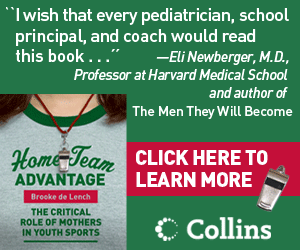Several years back, a group held a press conference in Washington, D.C. to issue a youth sports national "report card." The Citizenship Through Sports Alliance gave out the following "grades":
- Child-Centered Philosophy: D;
- Coaching: C-;
- Health and Safety: C+;
- Officiating: B-; and
- Parental Behavior & Involvement: D.
As the Alliance report card showed then - and I suspect that things haven't changed all that much since - almost all aspects of youth sports are getting poor grades. If your child brought home these grades, you would call his teacher and quickly come up with a plan to improve them.
Because parents come and go, because change at the national level is unlikely, the path towards fundamental change in youth sports will only be accomplished at the grass roots, community level. It is here that concerned mothers - and fathers - can make youth sports about having fun, make sports safer for our children, to include every child who wants a chance to play.
Here are some of the things parents can do in their own community to improve youth sports:
Listen to what children want. Studies repeatedly show that the vast majority of boys and girls, when asked what they would like to see changed about youth sports, say they would like to see less emphasis on winning. We need to start listening to what our children tell us they want.
Have the courage to speak up! Most parents in this country want a youth sports system that serves the interests of children. They represent a vast silent majority who just need the courage to stand up and band together to fight those who want to preserve a status quo serving the interests of adults. Perhaps the Wisconsin Interscholastic Athletic Association said it best: "Carrying the torch for less pressure and more perspective in youth programs may not be a popular position. Those who demand more games, more wins, more trophies, more travel and more of everything can talk the loudest and sound convincing. It's up to all of us to have the courage to be just as passionate on the side of balance."
Push to reform school athletic programs and PE. As John Gerdy writes in his book, Sports in School, "our sports programs are elitist and exclusionary, neither designed nor conducted with the health benefits of participants in mind." He argues that "If we were interested in deriving the greatest health return on dollars spent on athletics, more resources would be spent on broad-based, participatory intramural, club and physical education programs than on the current programs designed to cater to a small population of elite athletes."
Fundamentally altering the outmoded model that most schools follow for interscholastic sports will be a monumental undertaking. It will require the effort of a large and vocal group of committed parents. But it can be done. First, try to eliminate cutting at levels below high school varsity.
Second, accommodate the interests of those students not playing competitive team sports but who want to continue to engage in some form of physical exercise or sports in a non-competitive setting, by reforming and expanding school-based physical education programs and by developing and funding after-school programs offering aerobics, dance, exercise walking, self-defense, yoga, pilates, strength training, flag/touch football, and Ultimate Frisbee.
The Women Sports Foundation's 2008 survey, Go Out and Play: Youth Sports in America, supports this recommendation. It reports that many of the nation's schools "have cut back on physical education offerings or stopped requiring 'gym classes' entirely. One in five U.S. schools does not offer physical education (PE) at all, and despite Centers for Disease Control recommendations, only handfuls of elementary, middle and high schools offer daily PE classes (i.e., 4%, 8% and 2%, respectively)."
The Women Sports Foundation report contains a number of important recommendations:
- Nationally and regionally scaled steps should be taken to counteract the downturn in physical education attendance among high school girls.
- Local, state, and federal health planners need to further invest in physical education and youth sports as key elements of preventive health policy. Guidelines and practices should be developed to close the gap in physical education between girls and boys, girls of color and Caucasians, and schools in poor communities and more affluent communities.
- School boards can reverse the cuts in PE offerings, make PE mandatory, and broaden the curriculum to appeal to the wide range of girls' interests in exercise and physical activities. Increasing opportunities for exercise in PE classes are also likely to be a highly effective mechanism for infusing exercise into the lives of children who do not like sports.
- School officials can seek grants to initiate, expand, and improve their physical education programs for K-12 students through the Carol M. White Physical Education Program (PEP). For information on how to apply, click here.
- Schools and communities can seek information and resources in order to enhance their existing health and physical education programs.
Third, ask schools to consider returning to same-sex PE. Co-ed physical education, while it has obvious advantages, also has some significant downsides for both boys and girls. A study of South Carolina middle and high school girls reported in the September 2005 issue of the American Journal of Public Health found that girls taking girls-only PE exercised substantially more than girls in co-ed programs. As for boys, those who support the current shift in the physical education curriculum away from traditional competitive sports, often involving an aggressive component, towards aerobic activities such as riding a stationary bicycle or jogging, argues Dr. Leonard Sax, are ignoring the fact "that many boys need the aggressive element found in sports such as basketball and soccer" and that the result "is that boys who aren't athletic enough to make the team now have no socially acceptable outlet for their aggressive impulses."









